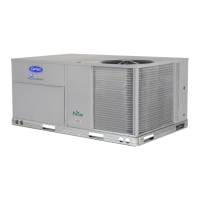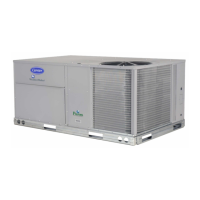73
• Return air humidity sensor
• Outside airflow control
NOTE: All these options require the CEM.
The P Series economizer damper is managed by a communi-
cating actuator motor(s). This provides the ability of the con-
trol system to monitor, diagnose, and report the health and op-
eration of the actuator and damper system to the local display
and CCN network, thus providing extensive diagnostic tools to
servicers.
ECONOMIZER FAULT DETECTION AND DIAGNOSTICS
(FDD) CONTROL
The Economizer Fault Detection and Diagnostics control can
be divided into two tests: test for mechanically disconnected
actuator and test for stuck/jammed actuator.
Mechanically Disconnected Actuator
The test for a mechanically disconnected actuator is performed
by monitoring SAT as the actuator position changes and the
damper blades modulate. As the damper opens, it is expected
SAT will drop and approach OAT when the damper is at 100%.
As the damper closes, it is expected SAT will rise and approach
RAT when the damper is at 0%. The basic test is as follows:
1. With supply fan running take a sample of SAT at current
actuator position.
2. Modulate actuator to new position.
3. Allow time for SAT to stabilize at new position.
4. Take sample of SAT at new actuator position and determine:
a. If damper has opened, SAT should have decreased.
b. If damper has closed, SAT should have increased.
5. Use current SAT and actuator position as samples for next
comparison after next actuator move.
The control will test for a mechanically disconnected damper if
all the following conditions are true:
1. An economizer is installed.
2. The supply fan is running.
3. Conditions are good for economizing.
4. The difference between RAT and OAT > E.SOD. It is nec-
essary for there to be a large enough difference between
RAT and OAT in order to measure a change in SAT as the
damper modulates.
5. The actuator has moved at least EC.ST %. A very small
change in damper position may result in a very small (or
non-measurable) change in SAT.
6. At least part of the economizer movement is within the
range ET.MN% to ET.MX%. Because the mixing of out-
side air and return air is not linear over the entire range of
damper position, near the ends of the range even a large
change in damper position may result in a very small (or
non-measurable) change in SAT.
Furthermore, the control will test for a mechanically discon-
nected actuator after E.CHD minutes have expired when any
of the following occur (this is to allow the heat/cool cycle to
dissipate and not influence SAT):
1. The supply fans switches from OFF to ON.
2. Mechanical cooling switches from ON to OFF.
3. Reheat switches from ON to OFF.
4. The SAT sensor has been relocated downstream of the
heating section and heat switches from ON to OFF.
The economizer will be considered moving if the reported po-
sition has changed at least ± EC.MD %. A very small change
in position is not considered movement.
The determination of whether the economizer is mechanically
disconnected will occur SAT.T/2 seconds after the economizer
has stopped moving. The control will log a “damper not modu-
lating” alert if:
1. SAT has not decreased by S.CHG degrees F SAT_SET/2
seconds after opening the economizer at least EC.ST%,
taking into account whether the entire movement has
occurred within the range 0-ET.MN%.
2. SAT has not increased by S.CHG degrees F SAT_SET/2
seconds after closing the economizer at least
EC.ST%,
taking into account whether the entire movement has
occurred within the range ET.MX-100%.
3. Economizer reported position <=5% and SAT is not
approximately equal to RAT. SAT not approximately equal
to RAT will be determined as follows:
a. SAT<RAT-(2*2(thermistor accuracy) + 2 (SAT increase
due to fan))
or
b. SAT>RAT+(2*2(thermistor accuracy) + 2 (SAT increase
due to fan))
4. Economizer reported position >=95% and SAT is not
approximately equal to OAT. SAT not approximately
equal to OAT will be determined as follows:
a. SAT<OAT-(2*2(thermistor accuracy) + 2 (SAT increase
due to fan))
or
b. SAT>OAT+(2*2(thermistor accuracy) + 2 (SAT increase
due to fan))
Except when run as part of a self-test, the control will not auto-
matically clear “damper not modulating” alerts on units with
more than one actuator (when ECON_TWO=YES); the alert
will have to be manually cleared.
Test for stuck/jammed actuator
The control will test for a jammed actuator as follows:
• If the actuator has stopped moving and the reported posi-
tion (ECONxPOS, where x is 1,2) is not within ± EC_FL-
GAP% of the command position (ECONOCMD) after
EC_FLTMR seconds, a “damper stuck or jammed” alert
will be logged; i.e., abs (ECONxPOS - ECONODMD) >
E.GAP for a continuous time period EC_FLTMR seconds.
• If the actuator jammed while opening (i.e., reported posi-
tion < commanded position), a “not economizing when it
should” alert will be logged.
• If the actuator jammed while closing (i.e., reported posi-
tion > command position), the “economizing when it
should not” and “too much outside air” alerts will be
logged.
The control will automatically clear the jammed actuator alerts
as follows:
• If the actuator moves at least 1%, the alerts will be cleared.
Alternate Excess Outdoor Air Test
For units configured with outdoor air measuring stations
(OCFMSENS=YES):
Configuration
ECON
CFM.C
OCF.S=YES
Under the following conditions:
1. Unit is not performing free cooling
2. OACFM sensor is detected as good
3. IAQ is not overriding CFM
4. Purge is not overriding CFM
If OACFM > (ECMINCFM + EX_ARCFM) for EX_ARTMR
seconds, the “excess outside air” alert will be logged.
DIFFERENTIAL DRY BULB CUTOFF CONTROL
Differential Dry Bulb Changeover
As both return air and outside air temperature sensors are in-
stalled as standard on these units, the user may select this option,
E.SEL = 1, to perform a qualification of return and outside air in
the enabling/disabling of free cooling. If this option is selected,

